
Canada's 158th birthday is coming up on Tuesday, July 1st, which is always a special time of the year, and even more so in 2025 considering the need to maintain our national sovereignty and support local Canadian companies.
An unforgettable Canada Day wouldn't be complete without fireworks, swimming, music, family, and of course firing up the barbecue and enjoying a home cooked meal outdoors! At Vincenzo's in Waterloo, we carry a wide variety of products from local Canadian companies — not only produced here in Ontario — but from across the country. You can visit us in-store in Waterloo at 150 Caroline St S, or shop online to place a grocery, catering or basket order. As a reminder, we are CLOSED for Canada Day.
Read on to learn about some of our Canadian brands that are offering new summer items; plan out your cocktail (or non-alcoholic drink) menu; get a head start on selecting some excellent local meat for the grill; support local by ordering a Canadian gift basket for your family and friends; and see how we can help cater your Canada Day party!
At Vincenzo's we carry a wide assortment of Canadian-made products, as it is important to support local and ensure we are reinvesting to uplift our communities. We have some exciting new and popular items that are ideal for summer snacking.
Ontario has some of the best produce available across the country, and the summer allows us to grow a wide variety of fresh goods. We are now carrying Ontario Strawberries, which are perfect for snacking as is, however you could incorporate them in a homemade strawberry rhubarb pie or strawberry shortcake. A unique option is Canadian-grown Haskap Berries, which have a tart flavour that is a mix between blueberry and raspberry, and can be used for baked goods, salads, smoothies, jams, and yogurt. In terms of vegetables, don't forget to pick up Ontario Asparagus while it's still available, as well as Ontario Tomatoes and Lettuce as a perfect topping for burgers.
For your summer salads, consider using Feige's Gourmet Dressings as a great local option from Listowel. They have perfect light fruity dressings such as Honey Mustard & Poppy Seed, and Raspberry. A newer option is the Matheson Food Company from popular Canadian celebrity chef Matty Matheson, who has a line of classic salad dressings that includes Italian, Greek, and Balsamic. If you would prefer to skip the mixing bowl, we offer pre-made salads ranging from potato and pasta salads to caprese.

We also carry a wide selection of grilling sauce, marinades, rubs and bread options as an accompaniment to your grilled meats. Kozlik's is a long-standing Canadian staple that have incorporated their mustard seed into their Pork Rub, Poultry Rub, and Steak Rub. A newer Canadian company is FLAVRBOMBS who offer rubs in a convenient resealable bag designed for effortless meals at home. Some of their options are Jolted Cowboy (American BBQ style), Piri Piri (Portuguese style), and Sweet Jerk (Caribbean style). A local company from right here in Kitchener is Phlippens, who produce their sauces in small batches with hand-smoked ingredients, ranging from Phlippen Original Sauce to Phlippen Jerk Sauce. As mentioned above, the Matheson Food Company also carries a line of BBQ sauces such as Maple Molasses and Bama. You can't forget bread as the vehicle for your grilled meats, so stop by and check out our selection of artisan buns and rolls from ACE Bakery, or pick up Martin's famous potato rolls and bread.

Offering snacks as an appetizer is the ideal way to tide your guests over until the grill gets going. Hardbite Chips from British Columbia has a range of classic flavours such as Smokin' BBQ, Ketchup, and Smoked Paprika & Garlic. One of our most popular brands is Covered Bridge, and their seasonal The Weekender chips always sell out, which is a blend of vinegar, pepper, barbeque and jalapeno all in one. Barrie's Asparagus offers a line of snacks including Pita Crackers and Cracked Wheat Crackers. To pair with these salty snacks, you can't go wrong with any of our house-made dips, including Pesto Hummus, Bruschetta, Pimento, or Tzatziki.
If you have a pizza oven at home and are looking to fire it up this weekend, Vincenzo's has everything you need to craft high quality pizza. We offer pizza dough in our freezer section, as well as various sizes of our ready-to-use pizza crusts. For sauce, we carry many brands, but Favuzzi from Laval makes an excellent Pizza Tomato Sauce. In terms of toppings, we have everything from fresh mozzarella and burrata, kalamata olives from Greece, prosciutto from Niagara, chili oil, to Caputo 00 Flour to make your own dough. To top if off, you can't forget about the irresistible hot honey from Rosewood in the Niagara region.
Lastly, the best way to beat this recent heatwave is with a cold beverage. Lighthouse Lemonade from the Maritimes offers summer in a bottle with their Lemonade Cordial or Lime-Lemon Cordial, which are ideal for making large batches of lemonade. Of course, Fever Tree is one of our longstanding brands for drink mixes, with everything from Ginger Beer to Sicilian Lemonade. We also carry cases of La Croix across various flavours, which are convenient for parties, including Beach Plum, Mojito, Passionfruit, and Mango. A local brand from Guelph is the Hitchhiker Beverage Company who have a range of lemonade and cold teas such as Front Porch Peach, Sole Mileage Mango, and Casual Traveller Lemon. One of our new offerings is Balloon from Toronto, who have created an all-natural sparkling water as a soda alternative, with unique flavours such as Fruit Punch and Green Apple.
If you're serving up a large batch of summer cocktails, or even if you don't drink alcohol and are looking to beat the heat with a refreshment, Vincenzo's has a large variety of cocktail mixes, syrups, and alcohol-free spirits and beverages.
While entertaining on Canada Day, nothing pairs better with the barbecue than a refreshing cocktail. We offer a number of cocktail mixes to help you quickly whip up a pitcher for guests.
If you want to make a simple drink with a light fruity profile, Master of Mixes has a variety of options including a Mango Mixer, Mojito Mixer, Watermelon Mixer, and a Margarita Mixer. If you are looking for a classic cocktail, Stirrings makes it easy with their real juice mixes such as Simple Paloma, Cosmopolitan, or Margarita Mix. Another great company is Fever Tree who offers a Mojito, Margarita, and Caesar mix.

If you prefer to make your own cocktails from scratch, we have all the tools you need! Visit us in-store to purchase everything from glasses for cocktail, beer and wine; bitters and rimmers; premium cocktail ice from Hensall Ice Company; to a range of simple and cordial syrups.
Having a non-alcoholic option at your disposal ensures all of your guests feel included! Whether that is a ready-to-drink option such as a mocktail, non-alcoholic beer or wine, or an alcohol-free spirit, we have a growing portfolio of options.
Non-alcoholic beer is one of the fastest growing categories in North America, and there are no shortage of amazing options. Partake Brewing is a Calgary-based company with craft non-alcoholic beer such as Peach Gose, IPA, and Pale Ale. We also stock non-alcoholic options from popular brands including Peroni, Corona, and Heineken.
Ready-to-drink mocktails are another great option for your Canada Day celebration. Olé Cocktail Company is a newer Canadian brand that has perfect summer packs including Margarita, Paloma, and Chili Mango, which are made with Mexican agave nectar. Benjamin Bridge created Nova Scotia's first non-alcoholic wine spritzer Piquette Zero, which has expanded to three flavours in Original, Ruby, and Pink. Another popular brand is Harrington from Quebec who produces unique alcohol-free tonic cocktails such as Cucumber & Wintergreen, and Apple & Clover.
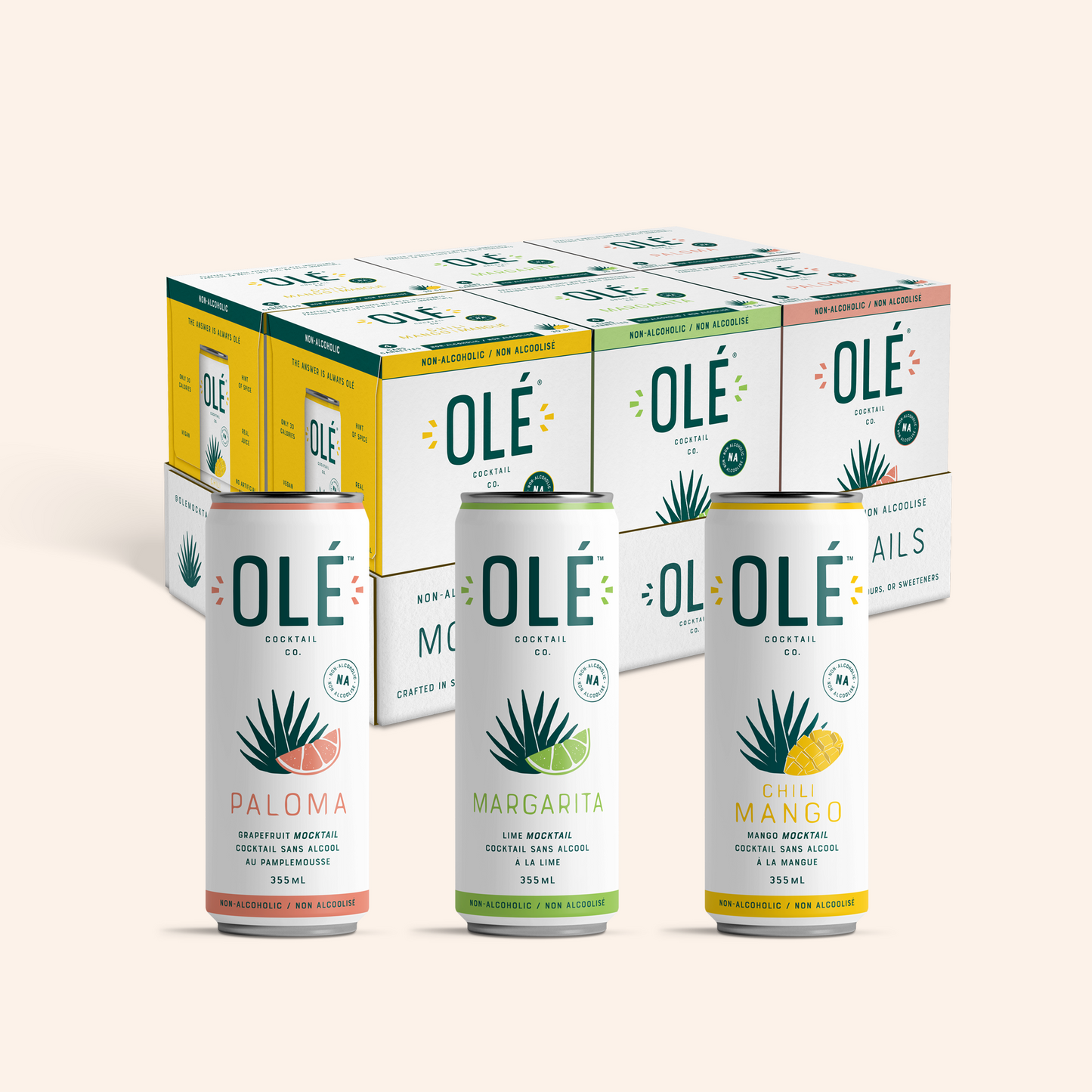
If you are looking to make your own mocktails with an alcohol-free spirit, Seedlip remains one of the most popular options. They have custom blends such as Grove 42 which has Mediterranean citrus notes, or Garden 108 as an herbaceous option. Another great local company is Sobrii from Stratford who produces highly-awarded spirit-free options in 0-Gin and 0-Tequila.
Rolling out the barbecue and firing it up for your family and friends is a staple of any Canada Day celebration. At Vincenzo's, we are partnered with the Bauer Butcher to provide a range of ethical and sustainably raised meats. They have a large selection that is perfect for this time of year:
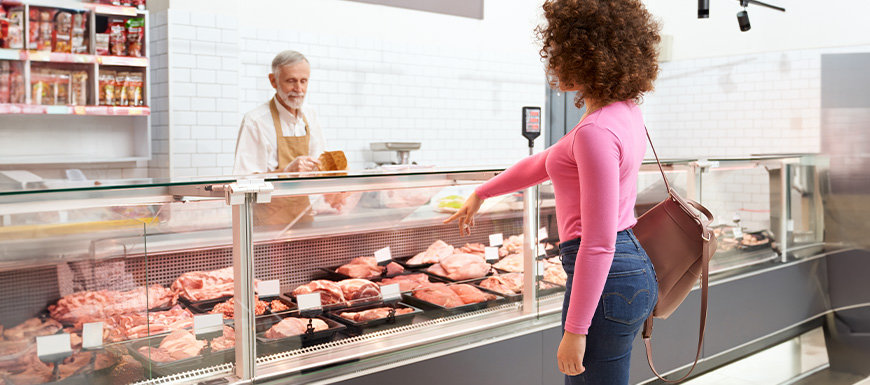
We also carry some frozen meat options including our popular house-made Mild Italian Sausage and Hot Italian Sausage, along with different types of Spiedini and Chevapi.
If you are unable to get together with the whole family, or maybe you have a friend across the country, consider celebrating what makes this nation unique by sending them a Canadian-themed gift basket. At Vincenzo's we offer pre-made gift baskets, however you can also modify them to your preference or create your own.
Our "A Taste of Canada" gift basket is the ultimate way to celebrate the holiday, as it contains an array of Canadian-made products from coast to coast. We have them ready to pick-up in-store or they can be modified if required. Some of the contents include the following:

To place your basket order, you can visit the "Gift Baskets" page on our website to order online, call (519) 741-1437 and ask for the Gift Basket department, or email [email protected].
If you're hosting a large gathering for Canada Day or heading up to the cottage on a tight schedule, Vincenzo's has the ideal catering solutions to help you host on a whim. Select from our assortment of sandwich trays, charcuterie boards, salads, fruit/veggie trays, or cooked entrees.
Some of our delectable offerings that are perfect for hosting during the summer:
To place your catering order, you can visit the "Catering" page on our website to order online, call (519) 741-1437 and ask for the Catering department, or email [email protected].
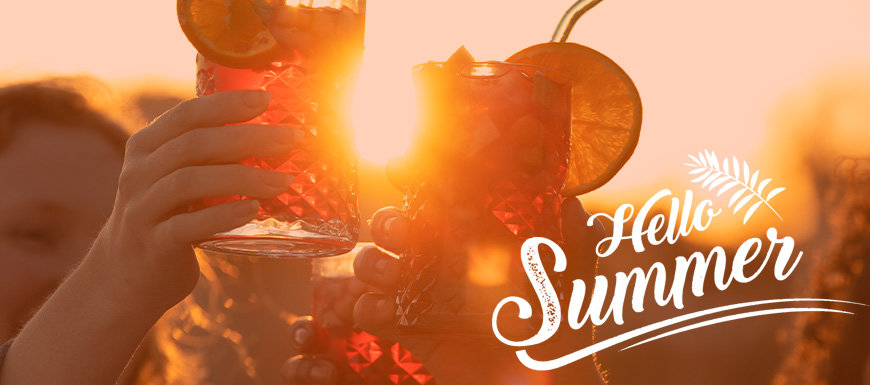
Summer is here! And with the arrival of beautiful warm sunny days, comes the time for light refreshing cocktails. Italian summer cocktails are perfect for summer entertaining because they are light and refreshing, often featuring a bitter-sweet balance with the use of liqueurs like Campari or Aperol.
They incorporate sparkling elements, such as Prosecco, for effervescence, and highlight the abundance of fresh fruits available during the season. These cocktails align with Italy's aperitivo culture, boasting vibrant colors, elegant presentations, and offering customization options. Overall, they capture the essence of summer with their flavourful and refreshing qualities, perfect for leisurely enjoyment in various settings.
Each has its own unique history and popularity, contributing to the vibrant and diverse Italian drinking culture. Enjoy exploring these delightful concoctions and savor the taste of Italy.
Aperol Spritz is a popular Italian aperitif that originated in the Veneto region. It also happens to be this author’s favourite summer drink! It was first created in the early 20th century by the Barbieri brothers, who owned a distillery in Padua. The recipe was later perfected by the Aperol company, which was acquired by Campari in 2003.
Aperol Spritz gained international popularity in recent years and has become a staple summer drink in Italy and beyond. Its vibrant orange color and refreshing taste make it a popular choice for warm weather gatherings and aperitivo hours.
An Aperol Spritz is made with Aperol, Prosecco, and a splash of soda water. It has a bittersweet flavor profile with notes of orange, rhubarb, and herbs. The Prosecco adds a light effervescence, while the soda water provides a refreshing fizz. The drink is typically garnished with a slice of orange or an olive.
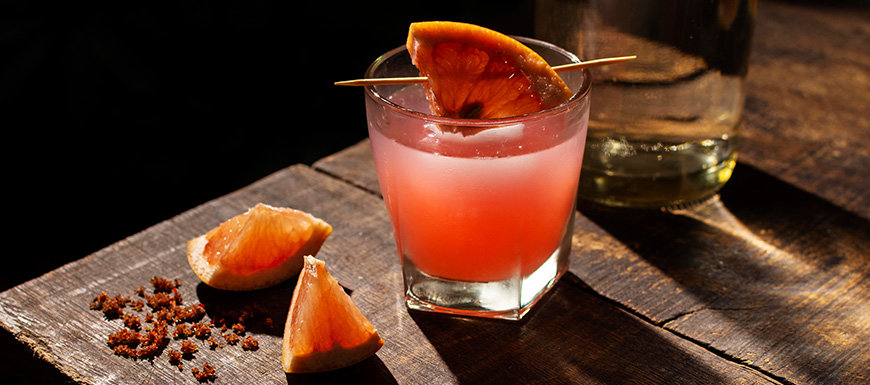
The Negroni Sbagliato is a variation of the classic Negroni cocktail. Legend has it that it was created by accident in the 1970s at Bar Basso in Milan when a bartender accidentally used sparkling wine instead of gin while preparing a Negroni.
The Negroni Sbagliato has gained a dedicated following, especially in Italy. It offers a lighter and bubblier alternative to the classic Negroni, making it a popular choice for summer sipping.
A Negroni Sbagliato is made with equal parts Campari, sweet vermouth, and sparkling wine (usually Prosecco). The resulting cocktail has a vibrant red color with a bitter-sweet taste. The sparkling wine adds a lively effervescence and a lighter profile compared to the traditional Negroni.
The Italian Fizz is a simple and refreshing cocktail that doesn't have a specific historical origin. It is a popular choice for hot summer days and can be easily customized with various fruit flavors.
The Italian Fizz is a lesser-known cocktail outside of Italy but is enjoyed by locals during the summer season. It provides a delightful combination of fizziness and fruity flavors.
The Italian Fizz typically combines Prosecco or sparkling wine with a fruit-flavored liqueur or syrup. Common fruit choices include peach, strawberry, or raspberry. The cocktail is garnished with fresh fruit or a sprig of mint. It offers a vibrant, fruity taste with the effervescence of the sparkling wine.
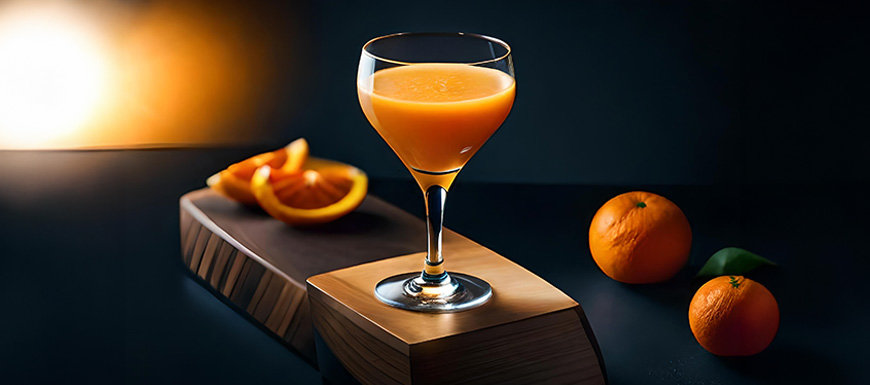
The Bellini cocktail was invented in the mid-20th century by Giuseppe Cipriani, the founder of Harry's Bar in Venice. He named the drink after the Italian Renaissance painter Giovanni Bellini, whose artworks often featured soft peachy hues.
The Bellini gained popularity in Venice and quickly spread to other parts of Italy and the world. It is considered a classic Italian cocktail and is particularly associated with celebrations and brunches.
The traditional Bellini is made with white peach puree and Prosecco. The peach puree lends a delicate, sweet flavor, and when combined with the sparkling wine, it creates a light and refreshing cocktail. Some variations may use other fruits like strawberry or raspberry instead of peach.
Campari, a vibrant red Italian liqueur, was created in 1860 by Gaspare Campari. It gained popularity as an aperitif throughout Italy and eventually became a common ingredient in cocktails.
Campari and Soda is a classic Italian drink that is widely enjoyed as a refreshing summer beverage. Its simplicity and bitter-sweet taste make it a popular choice for those who appreciate the distinct flavor of Campari.
Campari and Soda is made by combining Campari liqueur with soda water. The resulting drink has a bold bitter flavor with notes of herbs, spices, and citrus. The soda water adds effervescence and a crisp finish.
Sanguinello is a cocktail that celebrates the blood orange, a citrus fruit commonly found in Italy. The history of the drink itself is not well-documented, but it is a popular choice during the blood orange season.
Sanguinello is most popular in regions where blood oranges are grown, such as Sicily and Calabria. It is enjoyed during the peak season of blood oranges and showcases their unique flavor.
Sanguinello typically combines blood orange juice with sparkling wine or Prosecco. The cocktail has a vibrant red color and a sweet-tart taste profile. The blood orange imparts a distinct flavor with hints of raspberry and citrus, while the sparkling wine adds effervescence and elegance.
Sgroppino is a refreshing Italian cocktail that originated in the Veneto region, particularly in Venice. It is believed to have been created as a palate cleanser to be enjoyed between courses during a meal.
Sgroppino is popular in Italy, especially in the coastal regions, where it is often served as a digestif or a refreshing treat during hot summer days.
Sgroppino is made by combining lemon sorbet, vodka, and Prosecco. The resulting cocktail has a creamy texture with a tangy and citrusy flavor. It is light, frothy, and refreshing, making it an ideal summer drink or a delightful way to end a meal.
The Garibaldi Cocktail is named after Giuseppe Garibaldi, an Italian general and key figure in the unification of Italy in the 19th century. The cocktail's creation is attributed to a bartender at Bar Camparino in Milan.
The Garibaldi Cocktail is popular in Italy, particularly in Milan, where it is considered a classic aperitivo cocktail. It has gained international recognition for its simplicity and unique flavor combination.
The Garibaldi Cocktail is made by combining Campari and freshly squeezed orange juice. The drink has a vibrant orange color and a bittersweet taste profile. The bitterness of the Campari is balanced by the sweetness and acidity of the orange juice, creating a harmonious and refreshing beverage.

Limoncello is a traditional Italian liqueur that originated in Southern Italy, particularly in the Amalfi Coast and the island of Capri. It is believed to have been created by monks who used locally grown lemons to make a refreshing and aromatic liqueur.
Limoncello has gained popularity both in Italy and worldwide. It is commonly enjoyed as a digestif or used in cocktails and desserts.
Limoncello is made by infusing lemon zest with alcohol, typically vodka, and sweetening it with simple syrup. The resulting liqueur has a bright yellow color and a strong, zesty lemon aroma. It has a sweet and tangy flavor with a pronounced lemony taste and a smooth, slightly syrupy texture.
The Limoncello Spritz is a variation of the popular Aperol Spritz. It is a refreshing cocktail that showcases the vibrant flavors of Limoncello.
The Limoncello Spritz is enjoyed in Italy and has gained popularity as a summer cocktail abroad. It offers a citrusy twist on the classic Aperol Spritz.
The Limoncello Spritz combines Limoncello liqueur with Prosecco and soda water. The cocktail has a vibrant yellow color and a sweet, tangy, and citrusy flavor profile. The Limoncello adds a pronounced lemon zest taste, while the Prosecco and soda water provide effervescence and balance.
The Americano Cocktail has a fascinating history and is said to have been created in the 1860s in Gaspare Campari's bar in Milan. Originally known as the "Milano-Torino," it was later renamed the "Americano" due to its popularity among American tourists.
The Americano Cocktail is a classic Italian drink that continues to be enjoyed worldwide. It gained further fame as the favorite drink of James Bond in Ian Fleming's novels.
The Americano Cocktail is made by combining equal parts Campari and sweet vermouth with a splash of soda water. The resulting drink has a deep red color and a bitter-sweet taste. The Campari provides a pronounced bitterness with herbal and citrus notes, while the vermouth adds richness and complexity. The soda water adds a touch of effervescence and lightens the overall profile.
The Italian Paloma is a variation of the classic Mexican Paloma cocktail. The Italian twist incorporates bitter liqueurs commonly found in Italy.
The Italian Paloma is gaining popularity as a refreshing and vibrant cocktail. It offers a unique combination of bitter and citrus flavors.
The Italian Paloma combines tequila with bitter Italian liqueurs like Aperol or Campari, along with grapefruit juice and soda water. The cocktail has a vibrant pink color and a balanced taste. The bitter liqueurs add complexity and depth, while the grapefruit juice provides a refreshing citrusy tang. The soda water adds effervescence and lightness to the drink.
The Caffè Shakerato is a classic Italian coffee-based cocktail that originated in coffee bars and cafes throughout Italy. It is believed to have been created as a way to enjoy an iced coffee with a touch of elegance.
The Caffè Shakerato is a popular summer drink in Italy and is enjoyed for its energizing and refreshing qualities.
The Caffè Shakerato is made by shaking together espresso, simple syrup, and ice cubes until frothy. The resulting drink has a rich, velvety texture and a strong coffee flavor. It is served in a chilled glass and can be garnished with coffee beans or a sprinkle of cocoa powder.
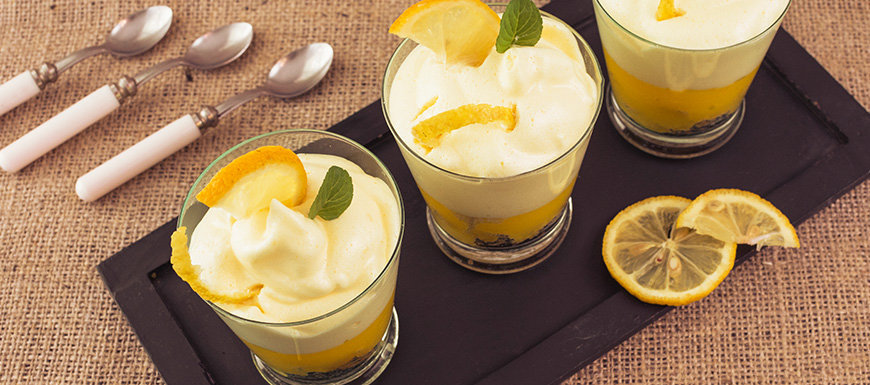
Bombardino is a warming Italian winter drink that originated in the Dolomite Mountains. It was created to provide comfort and warmth during the cold winter months.
Bombardino is particularly popular in ski resorts and mountainous regions of Italy, where it is enjoyed après-ski or as a cozy treat during the winter season.
Bombardino is made by combining equal parts Advocaat (a thick and creamy liqueur made from eggs, sugar, and brandy) and brandy or rum. The mixture is then heated and served hot. Some variations include adding whipped cream or a sprinkle of cinnamon on top. The resulting drink is rich, creamy, and indulgent, with flavors reminiscent of eggnog.
Italian summer drinks are the perfect companions for warm and sunny days, offering a refreshing and enjoyable experience. These cocktails feature light and thirst-quenching qualities, often striking a balance between bitter and sweet flavors by incorporating liqueurs like Campari or Aperol.
Sparkling elements such as Prosecco add effervescence, while the abundance of fresh fruits during the season infuses the cocktails with vibrant and fruity notes.
Rooted in Italy's aperitivo culture, these drinks are accompanied by delicious antipasti and other Italian delicacies, enhancing the overall experience. To explore these delightful concoctions and find the perfect pairing, one can visit Vincenzo's, a renowned purveyor of Italian food and ingredients.
Whether it's a zesty Aperol Spritz with a plate of bruschetta or a tangy Bellini complemented by a platter of Italian cheeses, the combination of these delectable drinks and authentic Italian cuisine creates an experience that truly captures the essence of a delightful Italian summer.

Vincenzo’s is known around the Waterloo Region for its commitment to offering customers a huge variety of high-quality products. Anyone who shops at Vincenzo’s will tell you that the selection of products is second to none, and the ability to find products no one else sells can be a lifesaver.
I can speak directly about this from my own personal experience. I needed to buy a Tagine (a Moroccan cooking pot) which I could not find at any of the big box stores, but I was able to find it at Vincenzo’s!
Part of offering the best quality foods means offering high quality meat products as well. Vincenzo’s proudly works with Bauer Butchers to provide their clients with locally and ethically sourced, top-quality cuts of meat.
Let’s take some time to learn about where your meat comes from, why local matters, and how ethically sourced meat matters.

First, let’s talk about big supermarket chains. Most consumers buy their meat at large supermarkets or retailers with grocery sections. And while not all supermarkets engage in negative practices, some concerns have been raised regarding certain practices related to meat in the supermarket industry.
Factory Farming
Supermarkets often source meat from large-scale industrial farming operations, also known as factory farms or concentrated animal feeding operations (CAFOs). These facilities prioritize high-volume production, often at the expense of animal welfare. Animals may be subjected to overcrowded and confined spaces, lack of access to pasture or natural environments, and routine use of antibiotics to prevent disease outbreaks.
Misleading Labeling
Some supermarkets may use misleading labels on meat products, leading consumers to believe that the animals were raised under better conditions than they were. Terms like "natural," "humane," or "farm-fresh" may not have standardized definitions, allowing for varying interpretations and potential greenwashing.
Low-Quality Standards
To maximize profits and reduce costs, supermarkets may source meat from suppliers that prioritize quantity over quality. This can result in lower-grade meat, potentially compromised in terms of taste, tenderness, and nutritional value. Additionally, some suppliers may use additives, preservatives, and fillers to enhance appearance or prolong shelf life.
Often supermarkets will repackage meat that has been sitting on the shelves into an alternative form. For example, steaks that don’t sell, sit on the shelves for a long period of time then are ground up and sold as ground beef.
Environmental Impact
Large-scale meat production for supermarkets can contribute to environmental issues. These include deforestation for feed production, excessive water usage, water pollution from manure runoff, greenhouse gas emissions, and the depletion of natural resources. Supermarkets that do not prioritize sustainable sourcing and production methods may contribute to these environmental concerns.
Food Waste
Supermarkets often generate significant amounts of food waste, including meat products. Overstocking, improper storage, and expiration dates can result in edible meat being discarded. The disposal of wasted meat has environmental consequences and represents a loss of resources.
It is important to note that not all supermarkets engage in these practices, and some are taking steps to improve their sourcing and sustainability efforts. As a consumer, you can make informed choices by researching the practices and policies of supermarkets, seeking out brands and certifications that prioritize animal welfare and sustainable farming methods, and supporting local and independent retailers that prioritize ethical sourcing.
Locally grown food carries several important benefits, which contribute to its significance:
Fresher and more nutritious: Local food tends to be harvested at its peak ripeness and delivered to consumers quickly, ensuring higher nutritional value and better flavour. Fruits and vegetables lose nutrients over time, so minimizing the transportation distance reduces the time between harvest and consumption.
Supporting local economy: Buying locally grown food directly supports local farmers and producers, helping to sustain their businesses and contribute to the local economy. This, in turn, helps create jobs and strengthens the community.
Environmental sustainability: Locally grown food reduces the carbon footprint associated with long-distance transportation. By minimizing the distance food travels, fewer fossil fuels are used for transportation, reducing greenhouse gas emissions and air pollution. Additionally, local farms often employ sustainable farming practices that promote soil health, biodiversity, and water conservation.
Preserving farmland and biodiversity: By supporting local farmers, we help preserve farmland and protect it from being converted to non-agricultural uses. This helps maintain green spaces, preserve rural landscapes, and protect wildlife habitats. Local farms also often prioritize heirloom and native plant varieties, contributing to the preservation of biodiversity and agricultural diversity.
Food safety and traceability: Locally grown food often allows for greater transparency and traceability. Consumers can have direct communication with farmers, gaining knowledge about farming practices, pesticide use, and food handling procedures. This transparency enhances food safety and builds trust between consumers and producers.
Community connection: Buying locally grown food fosters a sense of community and connection. It creates opportunities for farmers' markets, farm visits, and other community events that bring people together, promote social interactions, and strengthen the bond between consumers and producers.
Overall, supporting locally grown food helps create a more sustainable and resilient food system, benefits local economies, promotes environmental stewardship, and contributes to healthier and more vibrant communities.
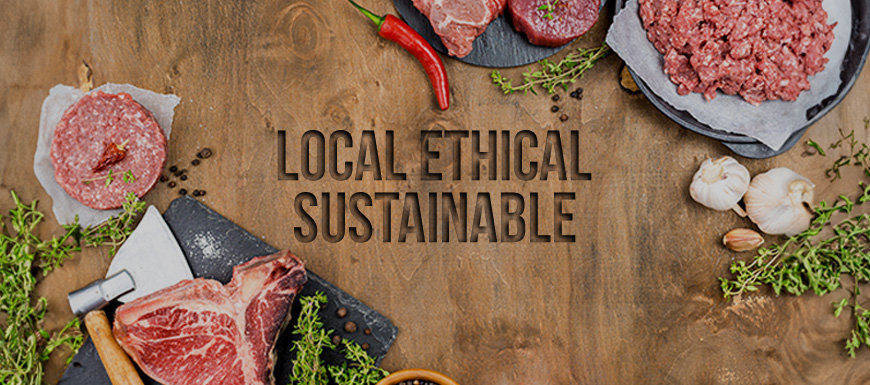
Farm-to-table is a culinary movement and philosophy that emphasizes the direct sourcing of ingredients from local farms and producers to create fresh, seasonal, and high-quality meals. The term "farm-to-table" highlights the journey of food from its origin on a farm to the dining table, minimizing the steps and distance involved in the food supply chain.
The primary goal of the farm-to-table movement is to promote sustainability, support local economies, and provide consumers with healthier and more flavourful food options. By sourcing ingredients directly from nearby farms, restaurants and chefs can ensure that the produce is picked at its peak freshness and flavour, often using organic or sustainable farming practices.
Farm-to-table dining also encourages a deeper connection between consumers and the food they eat. It promotes transparency, allowing people to know where their food comes from, how it is grown, and who grows it. This can foster a greater appreciation for the efforts of farmers and the importance of sustainable agriculture.
Furthermore, the farm-to-table approach often involves seasonal menus that change according to the availability of locally grown ingredients. This encourages a closer alignment with nature's cycles and reduces the environmental impact associated with long-distance transportation and refrigeration of food.
Overall, the farm-to-table movement promotes a more sustainable and environmentally conscious approach to food production and consumption, while also supporting local communities and providing consumers with fresher and more nutritious meals.
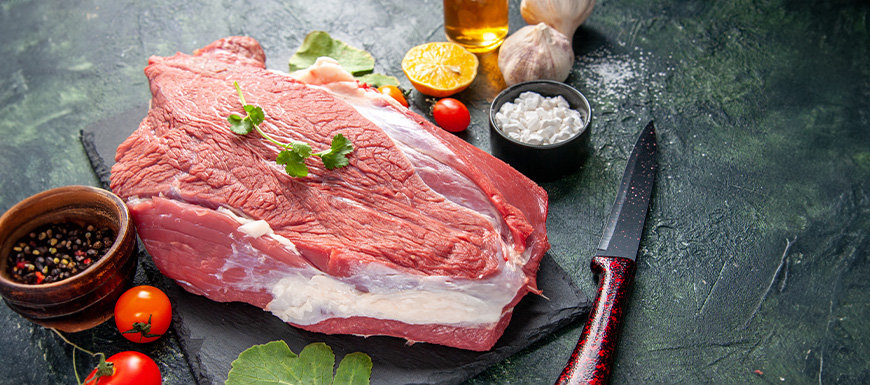
Ethically sourced meat refers to meat that is obtained through practices that prioritize the welfare and humane treatment of animals, as well as environmentally sustainable and socially responsible methods of production. It aims to address concerns about animal welfare, environmental impact, and worker conditions within the meat industry.
Ethical sourcing of meat typically involves the following principles:
Animal welfare: Ethically sourced meat prioritizes the well-being of animals throughout their lives. This includes providing them with appropriate living conditions, access to pasture or outdoor space, and avoiding practices such as overcrowding and confinement. It may also involve minimizing the use of antibiotics and hormones.
Sustainable farming practices: Ethical meat production promotes environmentally sustainable practices. This includes responsible land and resource management, minimizing water usage, reducing pollution, and adopting regenerative agriculture practices. Sustainable farming methods aim to protect ecosystems, preserve biodiversity, and mitigate the negative environmental impacts associated with meat production.
Transparency and traceability: Ethical sourcing emphasizes transparency in the supply chain, enabling consumers to know the origins of the meat they purchase. It may involve providing information about the farm or ranch where the animals were raised, the farming practices employed, and the processing methods used. This allows consumers to make informed choices based on their values and priorities.
Fair labour practices: Ethical sourcing extends beyond animal welfare and environmental considerations to encompass fair treatment of workers involved in the meat industry. This includes ensuring safe working conditions, fair wages, and proper training. Ethical meat producers strive to create a positive and equitable work environment for their employees.
Local and small-scale production: Ethical sourcing often emphasizes supporting local farmers and small-scale producers who adhere to high standards of animal welfare and sustainable practices. Buying from local sources reduces the carbon footprint associated with transportation and supports local economies.
Certifications such as organic, pasture-raised, Animal Welfare Approved, and Certified Humane are often used to indicate that certain standards of ethical sourcing have been met. These certifications provide assurance to consumers that the meat they are purchasing has been produced according to specific animal welfare and environmental criteria.
Choosing ethically sourced meat allows consumers to align their purchasing decisions with their values, promoting more sustainable and responsible practices within the meat industry.
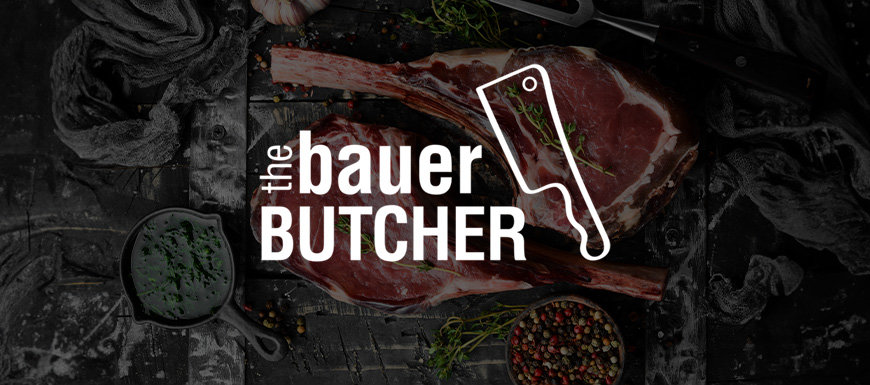
By working with the Bauer Butcher, Vincenzo’s can provide their customers with top quality meat that has been locally sourced, and ethically raised. The team at Bauer Butcher has long-standing relationships with Ontario farmers to that they can source the highest quality meat to give you the best farm-to-table experience.
Stop by Vincenzo’s today and see our quality selection of premium cuts!
Special Introduction to Vincenzo's customer.
Let us begin with an introduction to my company called GUSTOLOGIA which literally means THE STUDY OF TASTE. It is a mouthful to pronounce, but we always say we want it that way, with the tongue planted firmly in the cheek! I like to describe gustologia as an enthusiasm and a curiosity to search out the best tastes for maximum enjoyment. We also strive to understand why we experience what we do during the act of eating and drinking. And by offering delicious items on our gustologia website as well as tailor made gifts and events, we strive to offer a unique experience to our customer. As well, small group travel such as our trip to Puglia assist in creating gustologists worldwide!
Everything about Puglia is connected to the sea and to the sun, and it is predominantly agricultural with a mineral rich soil. There are many types of grains, fruits, olives, and almonds grown here. Puglia produces an astounding amount of Europe’s pasta, and more olive oil than all of Italy’s regions combined.
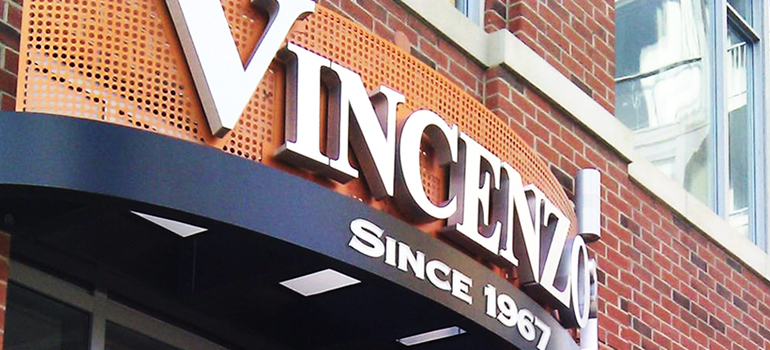
On May 5th for this special event, I will be stationed at Vincenzo’s to also showcase Masserie di Sant’Eramo, which is one of the beautiful spots we will visit in Puglia. Their estate is in the middle of the province in a hilly and arid zone. These exquisite Extra Virgin Olive Oils and pasta are award winning, but also authentic products from Puglia. “The Art of Healthy Living” is their philosophy, and central to their dedication to the Mediterranean diet. Masserie di Sant’Eramo Extra Virgin Olive Oil is the prime pure ‘juice’ that is extracted from the olives, without undergoing any chemical treatment whatsoever. The olives are pressed only once, within hours of being picked with Cold Extraction. This means that the producer does not resort to heat to increase yields. Only this process ensures a naturally low acidity level (less than 0.5%, and never chemically altered), a high nutritional content and the flavour of these premium olives which is kept intact, resulting in an oil of wonderful fullness.
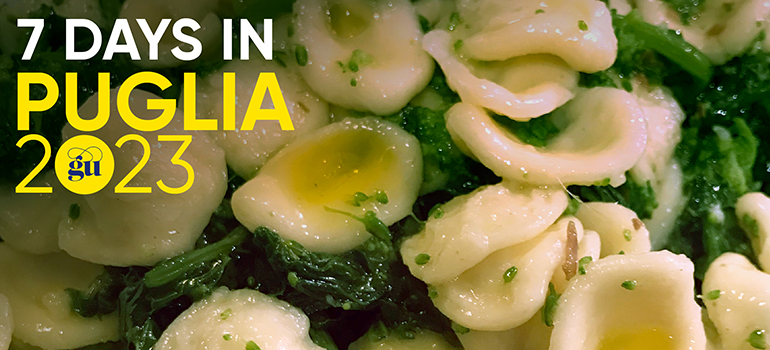
Orecchiette are very much a gastronomic symbol of Puglia. They require only three ingredients: Italian hard wheat flour, water and salt. Gustologists understand why it’s important to buy pasta made of various types of wheat cultivated in Italy – we discuss these topics frequently!
Translated as “little ears” in English, this pasta shape has become more and more popular as more is written and known about the region of Puglia. Orecchiette date back to between the 12th and 13th centuries, when they appeared in Bari, where they remain one of the city’s classic dishes. Some say they were inspired by the conical Trulli homes of Puglia. And today they are still made by hand in the streets of Bari where they are sold by weight. We will visit these markets in Bari where we can see, taste and purchase this wonderful pasta.
The classic way to eat this dish is with Rapini (cime di rapa) or turnip greens or sometimes broccoli, with a good amount of garlic. Orecchiette can also be dressed with a simple tomato sauce, and a grating of local ricotta made of sheep’s milk. And of course, a delicious Pugliese EVOO like Masserie di Sant’Eramo is a must to drizzle on top, or cook alongside the chef’s chosen vegetables.
Here is an authentic Pugliese recipe given to us from Masserie di Sant’Eramo:
500g Orecchiette Pasta “Masserie di Sant’Eramo”
“Masserie di Sant’Eramo” Extra Virgin Olive Oil
1 -2 bunches of Rapini (turnip tops)
3 garlic cloves, whole
8 anchovy fillets
1 to 2 dried or fresh hot peppers, broken up or chopped (this ingredient can be omitted for no spiciness, or heat)
Black pepper to taste
Sea salt to taste
Wash and cut rapini in small pieces of about an inch, discarding the hollow end of the stem and the bigger, thicker leafs. Set aside.
Bring a large pot of water to a boil and salt it. Add the Orecchiette and cook until al dente.
Use this time to heat the extra virgin olive oil in a small saucepan.
Sauté the garlic clove in extra virgin olive oil, along with the anchovy fillets and the hot red peppers.
Two to three minutes before the Orecchiette are ready, add rapini to water stirring often. Once cooked, drain the orecchiette and turnip tops and add them to the sauté and mix over a high heat for few minutes.
Toss to combine everything. Add pepper to taste.
Serve immediately, sprinkle over a tablespoon of grated and grilled bread, if desired.
Make sure you cook the garlic at low heat to avoid burning it.
Drain heavily, as water left in the pasta might dilute the taste of the dish.
You can blend part of the cooked rapini together with a bit of cooking water to get a creamier texture.
You can drizzle a little high-quality olive oil over the dish right when you serve, too.
You can replace Rapini with Broccoli.
Contact us at info@gustologia for more details and itinerary.
Browse our website: https://www.gustologia.ca/

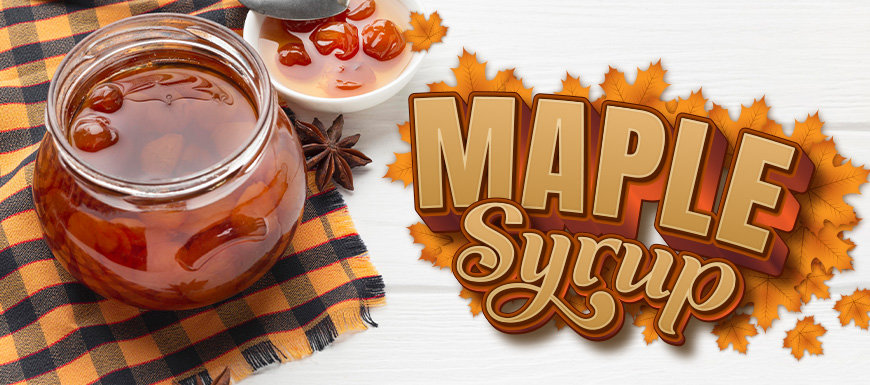
Maple Syrup is the breakfast staple, used across North America and in parts of Europe to top off the perfect breakfast. Used on pancakes, waffles, crêpes, and sometimes even eggs. Maple syrup is seen as the perfect topper for your breakfast; however, it is no longer just for pancakes anymore. Maple syrup is one of the healthiest sugars and is used in a variety of different desserts and other dishes.
Since its creation in early North America, it has been used in a variety of different foods, from cooking meats to sweetening drinks. Maple syrup is one of the most diverse sugars and can be used for almost anything. Although it is seen as a modern sugar it has been around for centuries and has been used in many ways since its creation. Only in modern times have we begun to restrict our use of it within food. Here at Vincenzo’s, we are all about being creative with food and bringing back old culinary traditions, so we encourage you to take some time and learn a little bit more about maple syrup and its different uses.
Visit Vincenzo’s online or in-store today to pick up some real Canadian maple syrup and begin experimenting in the kitchen.

Maple syrup has been around for centuries and has a long history here in North America. Everyone knows that the original steps for creating and refining maple syrup was invented by the Indigenous peoples of North America, but do you truly know the history of it?
The first known creation of maple syrup was produced by the Indigenous peoples of northeastern North America long before European settlers arrived. There is no true account of when maple syrup was first invented or how or why, but there are however legends and oral accounts told by Indigenous tribes. One of the most popular legends is that it was first used in place of water to cook venison for a tribal chief.
We do know how they harvested the sap from the trees and when. The Indigenous tribes began to develop rituals around the sap harvesting and syrup making. They would celebrate the Sugar Moon (the first full moon of spring) with a Maple Dance. This is when they would begin to harvest the sap, as it began to thaw from the winter.
Algonquians realized the nutrition of maple syrup and its uses and began to harvest it. They started by creating a V-shaped incision into the tree. Then they would insert either a reed or concave piece of bark to function as a spout. They would then place a clay bucket or tightly woven birch bark basket underneath the spout to collect the sap. After the bucket was full, they would then leave it out overnight to remove the ice layer that would form on-top. The next day they would then use a sled pulled by large animals to transport the many buckets over to a communal area where they would then be placed on a fire to concentrate the sap into syrup.
This method was used by Indigenous tribes for generations as they easiest way to collect the sap and turn it into syrup. They would then use the syrup in a variety of ways as it provided energy and nutrition.
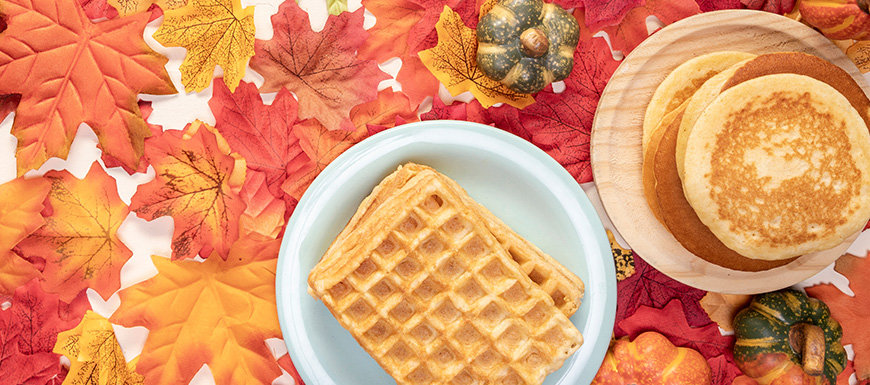
Soon European settlers and voyagers began to arrive in North America. The Indigenous peoples then began to show them how to tap the maple trees to collect sap. By the late 1600’s the Europeans were fully involved in the sap harvesting and syrup making process. It was used by the Europeans as their main source of sweetener for decades as cane sugar had to be shipped all the way from the West Indies.
Europeans then began to improve upon process by drilling tap holes with augers into the trees instead of making a V-shaped incision. They also replaced the reeds or concave bark pieces with wooden spouts and began to hang the buckets from the spouts rather than leaving them on the forest floor. After the buckets were full the sap was then transferred to a larger container like a barrel and then the bucket was placed back on the spout. This was repeated until the larger container was full. The large containers would then be transported to the communal area where they were poured out into large metal containers for boiling and concentration.
Europeans quickly adapted to the ways of the Indigenous when it came to harvesting the sap of the maple trees, they did however, improve upon the process to make it easier. As the centuries went on more and more changes and improvements were made to the tapping and concentration process to make maple production faster and easier.

After the original improvements of the Europeans, many more have been made throughout the centuries. Around the 1850’s cane sugar began to become more widely available again and began to replace maple as the main sugar source. Because maple syrup took so long to make it made it easier to switch over to using cane sugar. This sparked many maple producers to begin marketing more widely and improve upon their manufacturing process.
In 1858 the first patent was issued for an evaporator; it was used to heat and concentrate the sap. Around 1861-1865 they began to use flat metal sheets instead of cast iron kettles or big metal containers to boil the sap. This allowed the water to evaporate at a faster rate. In 1872 a new evaporator with two pans and a metal arch or firebox was invented to further improve the concentration process.
In the 1900’s they began to bend the tins that formed the bottom of the pans into a series of flues, which then increased the surface area of the pan, increasing the cooking process and decreasing the cooking time. They also began to replace the wooden buckets with plastic bags which allowed them to see how full they were from a distance. They also began experimenting with motor powered taps and metal tubing that would then carry the sap to a communal location and large container.
In the 1970’s the business of maple production began to be moved over to using plastic tubing, which had been perfected. They also began using vacuum pumps, pre-heaters which helped quicken the evaporating process, and reverse osmosis machines which took a portion of the water out of the sap, also improving the evaporating process.
The sap harvesting and maple production process has seen many changes since its creation by the Indigenous peoples of early North America. It is now pretty efficient; however, they are always making improvements to ensure it is as easy as it can be.

Maple syrup has been used in a variety of different ways in cooking, primarily on or in breakfast foods such as pancakes, waffles, crêpes, or muffins. Since its discovery by Indigenous peoples, it has been used to cook meats, in breads, and even eaten on its own. But how is it used today?
Around the 1930’s when sugar and maple became more expensive with the Great depression, it was used and bought more sparingly. It was used only in small amounts. This then led to many people in North America using it purely in their breakfast foods. However, now it is used in many ways again as people re-learn all different uses for it.
With the vegan movement more people are beginning to use it as a replacement for honey in recipes. Because it is so nutritious and low in calories the ongoing health movement has sparked people to begin to use it in a variety of different desserts instead of regular refined sugar. It is also being used for more savory foods as people rediscover all of its uses.

Despite Italy’s far distance from North America and its slow adoption of maple syrup as a product in cooking, a few chefs and people have begun to try and put a spin on traditional Italian cooking by adding in maple syrup. Italy is all about traditions and traditional cooking, so adding in new ingredients is not very common. However, in this modern world with new ingredients being shipped all over the world every day, some people have begun to experiment in the kitchen.
Here are some uses for maple syrup in Italian cooking:
A binder and sweetener for granola and cereal bars
A sweetener in ice-creams and gelatos, either on top or mixed in
A sweetener in cakes or biscuits (cookies), either on top or mixed in
To caramelize fruits
A sweetener for drinks, such as coffee, tea, or pop
A sweetener in salad dressings
A garnish for grilled or baked vegetables
Glazing for second courses such as meats, fish, or vegetables
Italian cuisines are varied from state to state and change across the country; however, they are all beginning to add in a little maple syrup. It creates a nice and sweet addition to any dessert, grilled vegetable, salad, or even on top of fish and meats.

Check out Vincenzo’s online or in-store today to pick a bottle or tin of real Canadian maple syrup, either plain or infused with additional flavour. It can be a great way to improve any meal or replace unhealthy sugars. It is no longer just for pancakes anymore.
